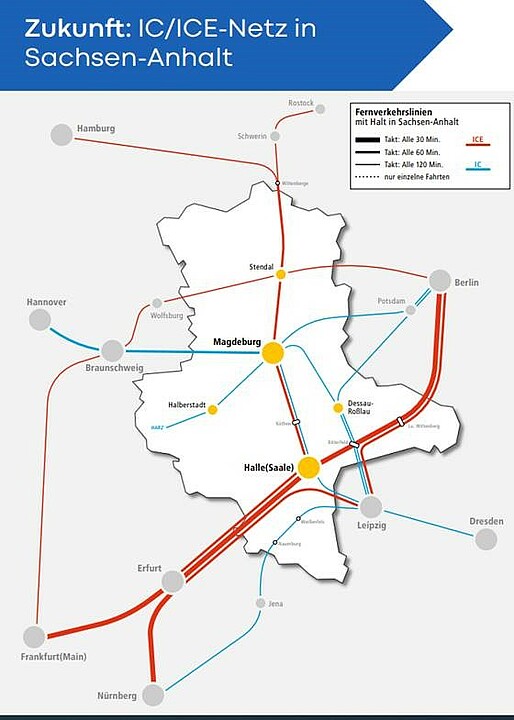Minister Hüskens calls for significantly better ICE connections in Saxony-Anhalt
Saxony-Anhalt needs a much better connection to the long-distance rail network. This was the central message of Dr. Lydia Hüskens, Saxony-Anhalt's Minister for Infrastructure and Digital Affairs, when she presented a strategy paper in Magdeburg today that will result in a list of demands to the federal government and Deutsche Bahn AG.
There is a need for action throughout the state, the minister emphasized. "In addition to Halle, Magdeburg must finally be connected to the metropolises of Berlin, Hamburg, Munich and Frankfurt am Main, as well as to western Germany via Hanover and to the neighboring economic areas of Rostock and Dresden. Hüskens emphasized that there was no alternative to expanding the state's long-distance transport network, not least in view of the imminent relocation of INTEL near the state capital and the establishment of the "Future Center for German Unity and European Transformation" in Halle, in order to be able to cope with the expected streams of commuters and visitors.
At the heart of the state's demands to the federal government and DB AG are several additional ICE lines. "In the long term, Berlin should be accessible by ICE from Magdeburg. In the medium term, it is absolutely necessary to increase the InterCity frequency to at least every two hours," says Lydia Hüskens, quoting key details from the state's strategy paper.
Nahverkehrsservice Sachsen-Anhalt GmbH (NASA) has developed very concrete and, above all, realistic proposals for the future long-distance transport concept in Saxony-Anhalt, the minister said at the press conference.
The basic prerequisite, of course, is a comprehensive expansion of the infrastructure to allow for significantly higher line speeds. For example, the Halle-Magdeburg-Stendal-Wittenberge axis must be upgraded to 200 kilometers per hour in order to further accelerate ICE traffic, she emphasized.
The integration of Saxony-Anhalt into the popular north-south axis Hamburg-Munich offers great potential for expanding services. At present, this route runs via Hanover or Berlin. Even under current conditions, a third route via Magdeburg would mean only a slight increase in travel time and would noticeably relieve congestion on the other two routes. DB AG is already planning to expand the Magdeburg-Stendal line in the next few years. "In the course of this, the train speed will have to be increased from the current 120 to an initial 160 kilometers per hour," the minister demanded.
As a third example from the strategy paper, Hüskens cited the extension of the Magdeburg-Berlin long-distance line to Halberstadt, which would create an efficient tourist axis between the German capital and the Harz Mountains.
According to the Minister, DB AG is planning an extensive construction program over the next eight years, which will undoubtedly place high demands on all rail passengers. "But with the implementation of our list of demands, which I am handing over to Deutsche Bahn AG and the Federal Ministry of Digital Affairs and Transport today, tangible improvements can be achieved," said Lydia Hüskens. The unfortunately unavoidable disruptions to local and long-distance traffic caused by the construction work can only be communicated to the public if our country gains significant locational advantages for the future as a result," she concluded.
The strategy paper and the detailed list of the state's demands can be found here: https://www.mein-takt.de/mehr-ice


